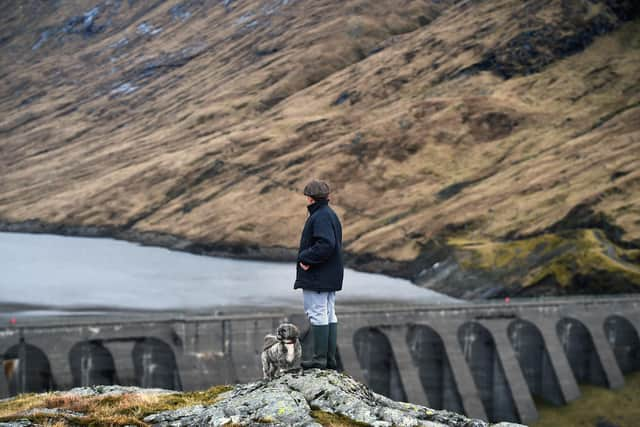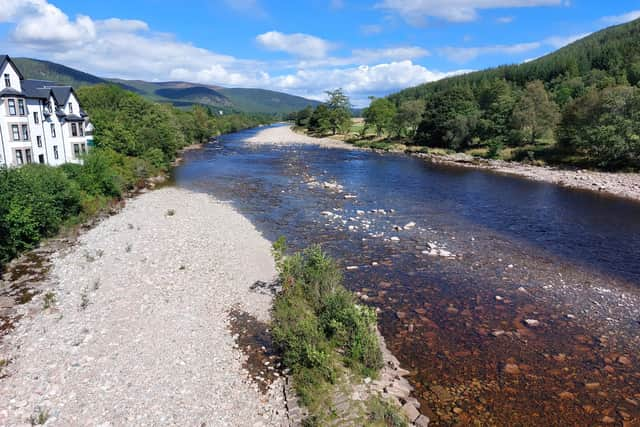How climate change - and less water - is impacting Scotland
The message may be a familiar one, usually greeted with dismay in a country famed for its wet weather. However, in this case many Scots are likely to be celebrating, after an unusually long dry spell across most of the country that has turned fields and gardens into parched deserts and prompted bans on taking water from key rivers.
With more than 25,500 lochs and 77,000 miles of rivers and streams – enough to run round the earth three times over – Scotland isn’t usually short of the wet stuff. But environmental regulators have in recent days suspended extraction from the Ythan in Aberdeenshire, where conditions are described as “extremely serious”, as well as the Tyne in East Lothian and Lower Tweed in the Borders. The move comes after similar restrictions were applied on the Eden in Fife and Upper Tweed last month – though these have since been lifted.
Advertisement
Hide AdAdvertisement
Hide AdWhile all of England’s south-west region is now officially in drought, the enduring arid spell is unexpected in a country renowned for its damp climate.
Rainy weather is an intrinsic part of our culture and national identity. Our language is full of colourful words to describe it – dreich, drookit, smirr, and all the rest – and it has long provided inspiration for our creatives, not just the aforementioned Aberdonian songstress.
It’s not too hard to work out what popular Scots band Wet Wet Wet were thinking about when they formed in the early 1980s. Something similar to what was going through – and soaking – the head of renowned Scots author and poet Robert Louis Stevenson back in back in 1800s, when he penned the lines: “The rain is raining all around, It falls on field and tree, It rains on the umbrellas here, And on the ships at sea.”
There’s an old saying – today’s rain is tomorrow’s whisky. It’s a brave attempt to look on the bright side when faced with yet another downpour, but it’s also true.
Scotland’s lush landscapes and iconic wildlife, not to mention our thriving tourism and leisure industries, internationally renowned food and drink and even renewable power, can be largely attributed to our soggy state of affairs. But could all of this be in peril as the planet suffers the increasingly dramatic impacts of climate change?


New record-high temperatures were recorded this summer in Scotland, England and Wales. The mercury shot up to 34.8C at Charterhall in the Borders, 37.1C at Hawarden Airport in Flintshire and 40.3C at Coningsby in Lincolnshire in July.
Overall Scotland has got damper as well as warmer. However, rainfall patterns have become much more erratic, with hotter, drier summers and milder, wetter winters and an increasing frequency of both droughts and flash flooding. And this ‘new normal’ is affecting pretty much everything we hold dear.
“Scotland’s climate is changing, bringing a range of environmental challenges and more frequent extreme weather events,” says Nathan Critchlow-Watton, head of water and planning at the Scottish Environment Protection Agency (Sepa).
Advertisement
Hide AdAdvertisement
Hide Ad“One effect in particular has been felt more than ever in recent weeks, as eastern parts of the country face water scarcity. Three catchments are currently at ‘significant’ level, the highest category defined by Sepa, and this means river and groundwater levels are critically low.


“As well as the ecological impacts of this, food and drink production, hydropower generation and other business activity reliant on a consistent water supply could be affected.
“With warmer temperatures and a decrease in summer rainfall predicted in the years to come, many places in Scotland are likely to face similar pressure on water resources, even if they have not experienced this before. Water is shared and finite, and we all need to work together to manage and preserve the resource as efficiently as possible.”
Dr Sarah Halliday, a lecturer in environmental science at the University of Dundee, says: “We all know that water is our most precious resource. However, in a water-rich nation such as Scotland many people may not have really considered how we use our water resources before.
“Where we may be familiar with the risk of flooding, the idea of water scarcity within Scotland could be very new.”


Recent years have highlighted vulnerabilities, she says. “Where on the one-hand we have had distilleries suspending production and water abstractions for farming halted due to reduced river flows, we have also seen landslides and urban flooding events, such as in Edinburgh city centre, caused by extreme rainfall events.”
She has also warned that hydro power and farming, with abstraction permits dependent on water levels and temperature, could suffer if reduced river flow becomes the norm. Lower rainfall and higher temperatures result in a greater need for crop irrigation, therefore exacerbating water shortages and threatening the future viability of many traditional crops.
And on top of disruption to business operations and services, extreme wet or dry conditions can also affect the quality of our water. “For example,” she says, “where we see higher temperatures and very low rainfall this leads to reduced river flows and inevitably increased pollution loads, as we are still discharging the same level of waste water into river systems but the level of rainfall to dilute it is much reduced.
Advertisement
Hide AdAdvertisement
Hide Ad“This in turn has implications for the ecology, with increased risk of toxic algal blooms, and use for recreation. In short, we may have a lot of water, but it’s not always in the right place at the right time, or of good enough quality for the purpose it’s needed.”
Landscapes, lochs and rivers
In 2020, Scotland’s nature agency published research showing the country is facing an increased risk of extreme droughts over the next two decades as a result of climate change, rising from an average of one in every 20 years to one in every three years.


“This can have wide-ranging impacts on nature as many of our most precious habitats and species are highly sensitive to changes in water levels,” says Debbie Basset, climate change manager for NatureScot. “For example, many wetland ecosystems are adapted to continual or frequent high water levels. Changes to these levels can reduce wetlands’ important role in the landscape, including filtering nutrients, absorbing carbon and slowing the flow of water.”
On top of pollution risks, climate change is causing lochs and rivers to heat up – which has a knock-on effect on freshwater habitats.
New research from Scotland’s Centre of Expertise for Waters (Crew), a state-backed partnership between the James Hutton Institute and Scottish universities, has revealed for the first time that climate change has already caused rapid and extensive warming of lochs and reservoirs across the nation, with impacts expected to intensify. The report shows temperatures have risen at 97 per cent of water bodies monitored between 2015 and 2019. While most warmed by up to 1C per year over this period, nearly a tenth saw higher annual increases – some as much as 1.3C.
Meanwhile, rivers are also reaching new record high temperatures – a factor known to adversely affect the distribution, health and survival of iconic cold water fish species such as brown trout and Atlantic salmon.
The findings have important implications for livelihoods across the country, with angling alone contributing £113 million per year to the Scottish rural economy.
The state of Scottish rivers has improved significantly over the last 25 years, according to official surveys, with nearly half now classed as in good condition or better. Almost two thirds of lochs assessed are in good or high condition, while nearly 80 per cent of groundwater bodies are in good condition.
Advertisement
Hide AdAdvertisement
Hide AdHowever, the combination of very low river flows and high temperatures in the water can kill off fish, insects and plants. While some parts of river ecology can bounce back quickly, others – such as Atlantic Salmon populations – can take years to recover.
Fisheries managers have welcomed the recent water extraction bans, but have criticised Scotland’s national water scarcity plan as “inadequate to protect fish stocks both in the short and longer term”. The River Tweed Commission has expressed fears for the survival of salmon and trout and called for a review of the system.
The concerns have been echoed by Andrew Graham-Stewart, director of environmental charity WildFish Scotland. “There is a pressing need to future-proof Scottish rivers, as far as is possible, against the negative impacts of climate change,” he says. “Plentiful clean water is obviously a fundamental prerequisite for healthy freshwater ecosystems and the key species, including wild salmon and trout, that depend upon them.
“Water abstraction is a major issue. There needs to be an urgent review of catchment transfers of water in Scotland and whether they can be justified.”
Industry
Water scarcity combined with soaring temperatures is also bad news for the Scotch whisky industry, according to Dr Rachel Helliwell, a senior research scientist at the James Hutton Institute (JHI) and recently appointed director of Crew and the Hydro Nation International Centre. “Without plentiful, good quality water there is no whisky,” she warns.
Whisky takes its name from uisge, the Gaelic word for water – one of just three ingredients used to make it. The golden spirit is Scotland’s most successful food and drink product, bringing in around £5.5 billion to the UK economy each year.
But recent summers have seen many distilleries forced to temporarily halt procedures due to water shortages but also because river temperatures were too high for the initial stages of whisky production.
In recent times distillers have been implementing a range of measures and systems to help reduce water usage, protect supplies and cut their environmental impacts.
Advertisement
Hide AdAdvertisement
Hide Ad“As a key ingredient used to make Scotch whisky, the industry knows it has a duty of care to protect and preserve Scotland’s water sources,” Anna Graham, the Scotch Whisky Association’s head of environment, science and innovation, says.
“During dry summers Scotch whisky distilleries have historically managed well. Industry sites often have shutdown periods over the summer months for essential maintenance, and distilleries will often flex these shutdowns as necessary to minimise the impact on the local water environment.”
Over the past decade, whisky producers have improved water efficiency by more than 20 per cent and the industry’s sustainability strategy commits distillers to achieving a ‘responsible use’ target by 2025.
Solutions
So what can be done to safeguard the things we currently take for granted – like wildlife, whisky, golf, fishing, farming and unlimited top-quality drinking water on tap?
A whole range of simple actions at home can save water. Don’t waste it, have shorter showers, shallower baths. Turn taps off when brushing your teeth, run fewer washing machine and dishwasher cycles, don’t flush the loo on every visit.
Halliday says we need to move to a place where water is valued by all of Scotland’s citizens and its use is an active consideration.
“As individuals we can often question what impact our actions can have,” she says, “but if everyone makes a small change the collective impact can be hugely beneficial.
“As people’s water use in Scotland isn’t metered, we need to think about how we raise public awareness about the value of water and drive more sustainable water use practices.
Advertisement
Hide AdAdvertisement
Hide Ad“We need to think about how we develop our public and private spaces to make sustainable water use the default, and to also build in space for water.
“Rainwater harvesting needs to become commonplace; and more investment is needed in grey water use, particularly in new homes and developments.”
Sepa monitors Scotland’s water resources and produces a weekly situation report between May and September, complete with advice on how industry users can be more efficient.
“We engage with businesses all year round to help them plan for water scarcity in the future and build resilience into their systems, whether that be switching to a borehole or incorporating appropriate off-line storage lagoons on their land,” says Critchlow-Watton. “Whilst our first aim is always to help people do the right thing, we will hold to account those who deliberately fail to comply with their legal responsibilities to protect local water environments.”
And Scotland’s national water and sewerage services company is working to tackle leaks, which have been cut from 1,100 megalitres a day in 2006 to around 459 megalitres now – a reduction of more than 50 per cent, but still a way to go since mega stands for million.
A spokesman for Scottish Water said: “In our network of more than 30,000 miles of water mains, we continue to target further reductions in leakage to prevent unnecessary waste of treated water, improve resilience of our water resources and help reduce the energy required to produce and distribute water to our customers. We work extremely hard to bring down leakage with measures including advanced technology to predict where and when leakage might occur.”
Farmers can irrigate crops at night to reduce evaporation and plant crops that are specially adapted to thrive in drier conditions.
Measures to control excess water and reduce damage from flooding are also important.
Advertisement
Hide AdAdvertisement
Hide AdExperts are looking more and more towards natural ways to make the landscape more resilient, including planting trees to help stabilise wet ground and provide shade to keep rivers cool, recreating bends in watercourses to slow flows, and restoring peatlands back to health so they can soak up and filter rainwater and flooding.
“The techniques are becoming more common throughout Scotland as part of river management planning,” says Helliwell.
“In short, these solutions involve protecting, restoring, and sustainably managing ecosystems in ways that increase their resilience and ability to address societal challenges, while also safeguarding biodiversity and improving human wellbeing.
NatureScot is also using ecological restoration as a way of maximising resilience against climate change, with projects such as PeatlandACTION, which has set more than 25,000 hectares of peatland on the road to recovery since 2012, with funding from the Scottish Government.
“We continue to focus on these kinds of nature-based solutions that are so essential in tackling the climate emergency facing us all, and we are working with land managers, Scottish Water and Sepa to develop this work further,” Basset says.
Helliwell adds: “There is growing awareness that nature-based solutions (NbS) can help to protect us from climate change impacts such as drought and flooding while slowing further warming, supporting biodiversity and securing ecosystem services.
“NbS, including the restoration of peat bogs to return them to net sinks of carbon dioxide from the atmosphere and re-meandering rivers to reduce flood risk, have been widely adopted in Scotland. By carefully placing them in the landscape it is possible to realise multiple benefits.
“In short, these solutions involve protecting, restoring and sustainably managing ecosystems in ways that increase their resilience and ability to address societal challenges, while also safeguarding biodiversity and improving human wellbeing.”
Advertisement
Hide AdAdvertisement
Hide AdGraham-Stewart also backs the use of natural defences to protect fish. “The benefits of riparian tree planting to provide shade to mitigate against high water temperatures, particularly in the headwaters of river systems, are now well recognised,” he says. “Some local initiatives are underway but we need a massive national programme without delay.”
Researchers from Crew have devised and tested out a range of schemes to help counteract water shortages, including the use of small dams to capture water when it rains and enhance groundwater recharge.
“The lessons learned can also potentially be applied to other areas of the economy that rely on private water supply and bring other potential benefits,” says Dr Josie Geris, a senior hydrology lecturer at the University of Aberdeen. “For example in flood management, improvements to biodiversity and water quality, the restoration of upland habitats and carbon storage.”
Meanwhile, the Scottish and UK governments have unveiled a joint plan to include new water-efficiency labels on taps, showers, dishwashers and washing machines in a move which could help save 1,200 million litres of water a day across the UK – the equivalent of 480 Olympic swimming pools.
Comments
Want to join the conversation? Please or to comment on this article.